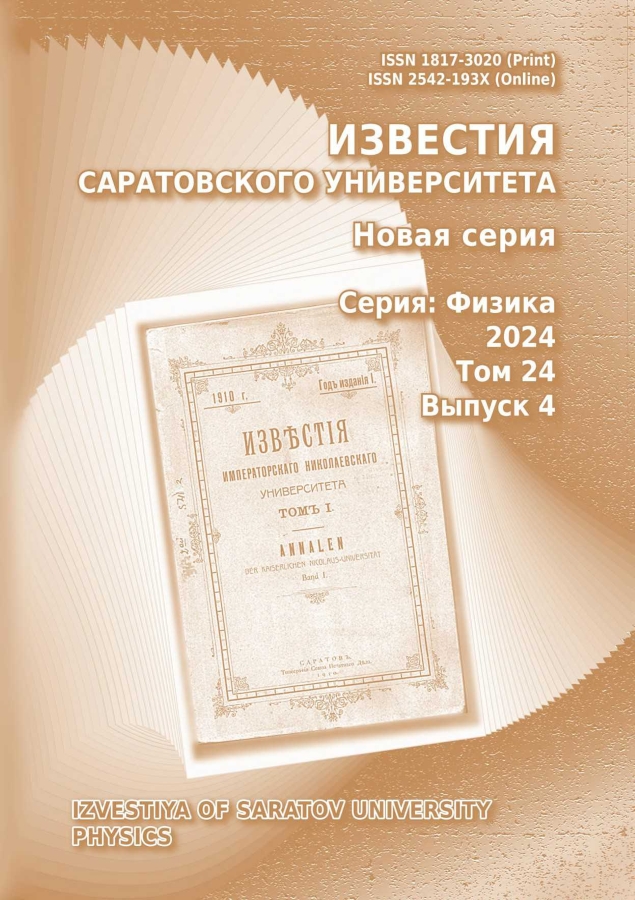Features of photo-stimulated adsorption of enzymes on semiconductor substrate
- Authors: Kozlowski A.V.1, Stetsyura S.V.1
-
Affiliations:
- Saratov State University
- Issue: Vol 23, No 4 (2023)
- Pages: 316-327
- Section: Articles
- URL: https://journals.rcsi.science/1817-3020/article/view/251247
- DOI: https://doi.org/10.18500/1817-3020-2023-23-4-316-327
- EDN: https://elibrary.ru/JMIHFG
- ID: 251247
Cite item
Full Text
Abstract
Keywords
About the authors
Alexander V. Kozlowski
Saratov State University410012, Russia, Saratov, Astrakhanskaya street, 83
Svetlana Viktorovna Stetsyura
Saratov State University410012, Russia, Saratov, Astrakhanskaya street, 83
References
- Malyar I. V., Gorin D. A., Santer S., Stetsyura S. V. Photocontrolled Adsorption of Polyelectrolyte Molecules on a Silicon Substrate // Langmuir. 2013. Vol. 29, iss. 52. P. 16058–16065. https://doi.org/10.1021/la403838n
- Маляр И. В., Santer S., Стецюра С. В. Влияние освещения на параметры полимерного покрытия, осаждаемого из раствора на полупроводниковую подложку // Письма в ЖТФ. 2013. Т. 39, вып. 14. С. 69–76. https://journals.ioffe.ru/articles/viewPDF/14567
- Стецюра С. В., Козловский А. В., Маляр И. В. Влияние типа проводимости кремниевой подложки на эффективность метода фотостимулированной адсорбции полиэлектролитов // Письма в ЖТФ. 2017. Т. 43, вып. 8. С. 26–33. https://doi.org/10.21883/PJTF.2017.08.44531.16545
- Козловский A. В., Стецюра С. В. Особенности формирования органического полиэлектролитного слоя на освещаемой полупроводниковой подложке // Известия Саратовского университета. Новая серия. Серия : Физика. 2022. Т. 22, вып. 3. С. 254–265. https://doi.org/10.18500/1817-3020-2022-22-3-254-265
- Dobrynin A. V., Deshkovski A., Rubinstein M. Adsorption of Polyelectrolytes at an Oppositely Charged Surface // Phys. Rev. Lett. 2000. Vol. 84, iss. 14. P. 3101–3104. https://doi.org/10.1103/PhysRevLett.84.3101
- Dobrynin A. V., Rubinstein M. Theory of polyelectrolytes in solutions and at surfaces // Prog. Polym. Sci. 2005. Vol. 30, iss. 11. P. 1049–1118. https://doi.org/10.1016/j.progpolymsci.2005.07.006
- Стецюра С. В., Козловский А. В. Влияние фотоэлектронных процессов в полупроводниковой подложке на адсорбцию поликатионных и полианионных молекул // Письма в ЖТФ. 2017. Т. 43, вып. 6. С. 15–22. https://doi.org/10.21883/PJTF.2017.06.44399.16510
- Kozlowski A. V., Stetsyura S. V. Kinetics of photostimulated adsorption of enzyme molecules onto nand p-type silicon // IOP Conference Series: Materials Science and Engineering. 2019. Vol. 699. Article number 012022 (4 p.). https://doi.org/10.1088/1757-899X/699/1/012022
- Григоренко В. Г., Андреева И. П., Рубцова М. Ю., Егоров А. М. Рекомбинантная пероксидаза хрена: получение и использование в аналитических целях // Биохимия. 2015. Т. 80, № 4. С. 480–488.
- Portaccio M., Lepore M. Determination of Different Saccharides Concentration by Means of a Multienzymes Amperometric Biosensor // Journal of Sensors. 2017. Vol. 2017. Article number 7498945 (8 p.). https://doi.org/10.1155/2017/7498945
- Кайгородов К. Л., Смирнова М. А, Тарабанько В. Е. Синтез диванилина в присутствии водной вытяжки и сока корня хрена // Журн. Сиб. федер. университета. Химия. 2020. Т. 13, № 4. С. 525–533. https://doi.org/10.17516/1998-2836-0195
- Harris J. M., Reyes C., Lopez G. P. Common Causes of Glucose Oxidase Instability in Vivo Biosensing: A Brief Review // Journal of Diabetes Science and Technology. 2013. Vol. 7, № 4. Article number 1030 (8 р.). https://doi.org/10.1177/193229681300700428
- Hecht H. J., Kalisz H. M., Hendle J., Schmid R. D., Schomburg D. Crystal structure of glucose oxidase from Aspergillus niger refined at 2.3 A resolution // J. Mol. Biol. 1993. Vol. 229, iss. 1. P. 153–172. https://doi.org/10.1006/jmbi.1993.1015
- Xie Y., Li Z., Zhou J. Hamiltonian replica exchange simulations of glucose oxidase adsorption on charged surfaces // Physical Chemistry Chemical Physics. 2018. Vol. 20, iss. 21. P. 14587–14596. https://doi.org/C8CP00530C
- Maslennikova A. A., Kozlowski A. V., Santer S., Stetsyura S. V. The influence of illumination and ionic strength of a solution on the formation of biosensor structure based on a silicon substrate and glucose oxidase molecules // Journal of Physics: Conference Series. 2019. Vol. 1400. Article number 077052 (6 p.) https://doi.org/10.1088/1742-6596/1400/7/077052
- Tan S., Gu D., Liu H., Liu Q. Detection of a single enzyme molecule based on a solid-state nanopore sensor // Nanotechnology. 2016. Vol. 27. № 15. Article number 1555021 (11 р.). https://doi.org/10.1088/0957-4484/27/15/155502
- Ahirwal G. K., Mitra C. K. Direct Electrochemistry of Horseradish Peroxidase-Gold Nanoparticles Conjugate // Sensors. 2009. Vol. 9, iss. 2. P. 881–894. https://doi.org/10.3390/s90200881
- Nandini S., Nalini S., Manjunatha R., Shanmugam S., Melo J. S., Suresh G. S. Electrochemical biosensor for the selective determination of hydrogen peroxide based on the co-deposition of palladium, horseradish peroxidase on functionalized-graphene modified graphite electrode as composite // Journal of Electroanalytical Chemistry. 2013. Vol. 689. P. 233–242. https://doi.org/10.1016/j.jelechem.2012.11.004
- Krainer F. W., Glieder A. An updated view on horseradish peroxidases: Recombinant production and biotechnological applications // Applied Microbiology and Biotechnology. 2015. Vol. 99. P. 1611–1625. https://doi.org/10.1007/s00253-014-6346-7
- Ferapontova E., Domínguez E. Adsorption of differently charged forms of horseradish peroxidase on metal electrodes of different nature: Effect of surface charges // Bioelectrochemistry. 2002. Vol. 55, iss. 1–2. P. 127–130. https://doi.org/10.1016/S1567-5394(01)00155-4
- Rennke H. G., Venkatachalam M. A. Chemical modification of horseradish peroxidase. Preparation and characterization of tracer enzymes with different isoelectric points // Journal of Histochemistry & Cytochemistry. 1979. Vol. 27, iss. 10. P. 1352–1353. https://doi.org/10.1177/27.10.41873
- Cloarec J. P., Chevalier C., Genest J., Beauvais J., Chamas H., Chevolot Y., Baron T., Souifi A. pH driven addressing of silicon nanowires onto Si3N4/SiO2 micropatterned surfaces // Nanotechnology. 2016. Vol. 27. Article number 295602 (10 р.). https://doi.org/10.1088/0957-4484/27/29/295602
- Movillia J., Huskens J. Functionalized Polyelectrolytes for Bioengineered Interfaces and Biosensing Applications // Organic Materials. 2020. Vol. 2, iss. 2. P. 78–107. https://doi.org/10.1055/s-0040-1708494
- Poghossian A., Abouzar M. H., Amberger F., Mayer D., Han Y., Ingebrandt S., Offenhausser A., Schoning M. J. Field-effect sensors with charged macromolecules: Characterisation by // Biosensors and Bioelectronics. 2007. Vol. 22, iss. 9–10. P. 2100–2107. https://doi.org/10.1016/j.bios.2006.09.014
- Garyfallou G. Z., de Smet L. C. P. M., Sudhölter E. J. R. The effect of the Type of doping on the electrical characteristics of electrolyte–oxide–silicon sensors: pH sensing and polyelectrolyte adsorption // Sensors and Actuators B: Chemical. 2012. Vol. 168. P. 207–213. https://doi.org/10.1016/j.snb.2012.04.010
- Aué J., de Hosson J. T. Influence of atomic force microscope tip-sample interaction on the study of scaling behavior // Appl. Phys. Lett. 1997. Vol. 71, iss. 10. P. 1347–1349. https://doi.org/10.1063/1.120415
- Makky A., Viel P., Chen S. W., Berthelot T., Pellequer J., Polesel-Maris J. Piezoelectric tuning fork probe for atomic force microscopy imaging and specific recognition force spectroscopy of an enzyme and its ligand // J. Mol. Recognit. 2013. Vol. 26, iss. 11. P. 521–531. https://doi.org/10.1002/jmr.2294
Supplementary files










